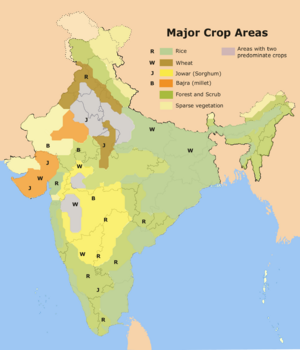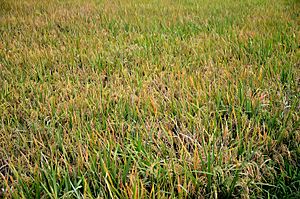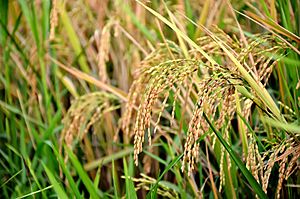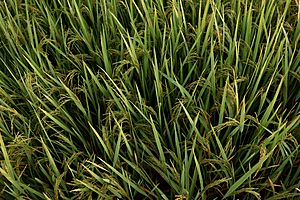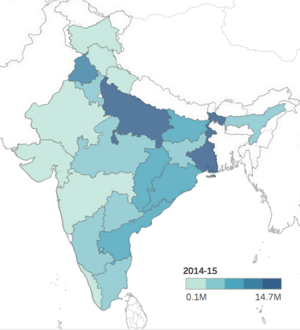Rice production in India facts for kids
Rice production in India is a very important part of India's economy. India is the second-largest producer of rice in the world, and it's also the biggest exporter of rice!
India's rice production has grown a lot, from about 53.6 million tons in 1980 to 120 million tons in 2020-21. Rice is one of the main grains in India. In fact, India has the largest area of land used for growing rice. It's a key food crop for many people in the country.
Rice is a tropical plant, so it loves hot and humid weather. It grows best in areas with lots of rain. This is why it's mainly a kharif crop in India. A kharif crop is planted during the monsoon season and harvested after the rains. Rice needs temperatures around 25 degrees Celsius or higher, and more than 100 centimeters of rain. In places with less rainfall, farmers use irrigation (watering systems) to grow rice. Rice is a main food for people in eastern and southern parts of India.
Contents
How Rice is Grown
Farmers in India use different ways to grow rice, but many still use traditional methods. First, they plow the fields and add natural fertilizers, like cow dung. Then, they smooth the field. Young rice plants are often moved by hand from a nursery to the main field. After that, they get plenty of water through irrigation.
Rice can grow in many types of soil, like silt, loam (a mix of sand, silt, and clay), and gravel. It can even handle slightly alkaline or acid soils. However, clayey loam soil is best for rice. Clayey soil turns into mud easily, which makes it simple to plant the rice seedlings. It's important to keep the soil wet and covered in water while the rice grows. Rice fields should be flat with low mud walls to hold the water. In flat areas, extra rainwater is allowed to flood the fields slowly. Rice grown in these well-watered, low areas is called lowland or wet rice.
In hilly areas, farmers cut the slopes into flat steps called terraces. This helps them grow rice on uneven land. Rice grown in hilly areas is known as dry or upland rice. Upland rice usually produces less rice per area compared to wet rice.
Where Rice is Grown in India
Rice is grown in many parts of India. Some of the main areas include:
- The western and eastern coastal strips, especially around river deltas.
- The Assam plains and nearby low hills.
- The foothills and Terai region along the Himalayas.
- States like West Bengal, Bihar, eastern Uttar Pradesh, eastern Madhya Pradesh, northern Andhra Pradesh, and Odisha.
Because India has a long growing season and many rivers like the Ganges-Brahmaputra, Kaveri River, Krishna River, Godavari River, Indravati River, and Mahanadi River, farmers can grow two, or sometimes even three, crops of rice each year. Big irrigation projects, like the Hirakud Dam and Indravati Dam, help with this. Even states like Punjab and Haryana, which have drier climates, can grow rice thanks to irrigation. They even send their extra rice to other states! The terraced fields in the hills from Kashmir to Assam are also great for rice farming, using old irrigation methods.
New types of rice plants that produce more, better planting methods, reliable water supply, and more use of fertilizers have all helped increase rice production quickly. However, areas that rely only on rain often have lower yields.
In some states, like West Bengal, Assam, and Orissa, farmers grow two rice crops a year. The winter in northwestern India is too cold for rice. Rice is a main crop in coastal India and parts of eastern India. Here, the high temperatures and heavy rainfall during summer and monsoon seasons are perfect for growing rice. Most parts of India can grow rice in the summer if there's enough water. This means rice is even grown in parts of western Uttar Pradesh, Punjab, and Haryana where low areas get flooded during the summer monsoon.
Winter rice crops take a long time to grow, while summer rice crops grow quickly. In some eastern and southern parts of India, a short-duration rice crop is followed by a long-duration one. Winter rice is usually grown in low-lying areas that stay flooded during the rainy season. Autumn rice is grown in Uttar Pradesh, Maharashtra, Rajasthan, Madhya Pradesh, Punjab, and Himachal Pradesh. West Bengal, Andhra Pradesh, Assam, and Orissa grow summer, autumn, and winter rice crops. The summer rice crop is smaller, but the winter rice crop is the main one, making up most of India's total rice production. Efforts have been made to increase how much rice is grown per hectare.
Rice Production by State
This table shows how much rice different states in India produced in 2014-15.
| States | Rank (2014–15) |
Actual Production (2014–15) |
% of Country Total (2014-15) |
Cumulative % of Country Total (2014-15) |
Average Production (2010-11 to 2014-15) |
Estimate (2015–16) |
| India | - | 103.73 | 100.0% | 100% | 105.48 | 103.61 |
| West Bengal | 1 | 14.68 | 13.9% | 14% | 14.54 | 16.10 |
| Uttar Pradesh | 2 | 12.17 | 11.5% | 25% | 13.45 | 12.51 |
| Punjab | 3 | 11.11 | 10.5% | 36% | 11.03 | 11.64 |
| Odisha | 4 | 8.30 | 7.9% | 44% | 7.17 | 5.80 |
| Andhra Pradesh | 5 | 7.23 | 6.9% | 51% | 7.34 | 6.94 |
| Bihar | 6 | 6.36 | 6.0% | 57% | 5.93 | 6.11 |
| Chhattisgarh | 7 | 6.32 | 6.0% | 63% | 6.37 | 6.29 |
| Tamil Nadu | 8 | 5.73 | 5.4% | 68% | 5.68 | 5.72 |
| Assam | 9 | 5.22 | 4.9% | 73% | 4.91 | 5.12 |
| Telangana | 10 | 4.44 | 4.2% | 77% | 5.31 | 4.19 |
| Haryana | 11 | 4.01 | 3.8% | 81% | 3.84 | 4.18 |
| Madhya Pradesh | 12 | 3.63 | 3.4% | 85% | 2.65 | 3.49 |
| Maharashtra | 15 | 2.95 | 2.8% | 94% | 2.93 | 2.61 |
| Gujarat | 16 | 1.83 | 1.7% | 96% | 1.66 | 1.56 |
| Uttarakhand | 17 | 0.60 | 0.6% | 96% | 0.58 | 0.63 |
| Kerala | 18 | 0.56 | 0.5% | 97% | 0.53 | 0.70 |
| Jammu & Kashmir | 19 | 0.52 | 0.5% | 97% | 0.60 | 0.42 |
| Rajasthan | 20 | 0.37 | 0.4% | 98% | 0.28 | 0.35 |
| Himachal Pradesh | 21 | 0.13 | 0.1% | 98% | 0.13 | 0.10 |
| Others | - | 2.44 | 2.3% | 100% | 2.37 | 2.31 |
Rice Export from India
India is one of the biggest countries that exports rice around the world.
Basmati Rice Exports
India is the top exporter of Basmati rice. Basmati rice is a special type of long-grain rice known for its unique smell and taste. In 2018-19, India sent out about 4.4 million metric tons of Basmati rice, which was worth 4.7 billion US dollars.
The Indian states that grow the most Basmati rice are Jammu and Kashmir, Himachal Pradesh, Punjab, Haryana, Delhi, Uttarakhand, and Western Uttar Pradesh. Basmati rice is a key ingredient in popular Indian dishes like Biriyani and Ghee Rice.
Non-Basmati Rice Exports
Any rice that is not Basmati rice is called Non-Basmati rice. In 2018-19, India exported 7.5 million metric tons of Non-Basmati rice, worth 3 billion US dollars. The main countries that bought this rice from India were Nepal, Benin, Senegal, Bangladesh, and Guinea.


